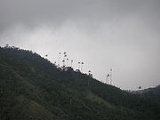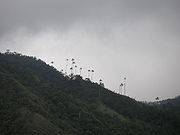
Yellow-eared Parrot
Encyclopedia
The Yellow-eared Parrot (Ognorhynchus icterotis), is an endangered
parrot
of tropical America. It is found in the western Andes
in Colombia
and (perhaps only formerly) Ecuador
and is closely associated to the wax palm Ceroxylon
sp. which is itself endangered.
, where it inhabits cloud forests about 1800–3000 meters above sea level. It nests in the hollow trunks of the palms, usually 25–30 meters over the floor level. It also occurred very locally in northern Ecuador
where wax palm grows. Their numbers had been greatly reduced, and only 81 individuals were recorded in the Colombian census of 1999. Their populations have been impacted by hunting and habitat destruction
, particularly the harvesting of wax palm, which was traditionally cut down and used each year on Palm Sunday. There has been no confirmed records of this parrot from Ecuador since the mid-90s.

than the upperparts. The heavy beak and a ring of bare skin around the eyes are black. The origin of the common epithet "yellow-eared" is caused for the yellow patch of feathers that extends from the forehead down to its cheeks and ear-coverts. The Yellow-eared Parrot mates for life. Its main source of food are the fruits of the wax palm.
with the support of Fundacion Loro Parque, American Bird Conservancy
and CORANTIOQUIA have undertaken (in Colombia) an intensive conservation project that has led to one of Latin America's most successful recoveries of a critically endangered bird. With protection and community support, the Yellow-eared Parrot population has climbed to over 1000 individuals.
Endangered species
An endangered species is a population of organisms which is at risk of becoming extinct because it is either few in numbers, or threatened by changing environmental or predation parameters...
parrot
Parrot
Parrots, also known as psittacines , are birds of the roughly 372 species in 86 genera that make up the order Psittaciformes, found in most tropical and subtropical regions. The order is subdivided into three families: the Psittacidae , the Cacatuidae and the Strigopidae...
of tropical America. It is found in the western Andes
Andes
The Andes is the world's longest continental mountain range. It is a continual range of highlands along the western coast of South America. This range is about long, about to wide , and of an average height of about .Along its length, the Andes is split into several ranges, which are separated...
in Colombia
Colombia
Colombia, officially the Republic of Colombia , is a unitary constitutional republic comprising thirty-two departments. The country is located in northwestern South America, bordered to the east by Venezuela and Brazil; to the south by Ecuador and Peru; to the north by the Caribbean Sea; to the...
and (perhaps only formerly) Ecuador
Ecuador
Ecuador , officially the Republic of Ecuador is a representative democratic republic in South America, bordered by Colombia on the north, Peru on the east and south, and by the Pacific Ocean to the west. It is one of only two countries in South America, along with Chile, that do not have a border...
and is closely associated to the wax palm Ceroxylon
Ceroxylon
Ceroxylon is a genus of flowering plant in the Arecaceae family, native to the Andes in Venezuela, Colombia, Ecuador, Peru, and Bolivia, known as Andean wax palms....
sp. which is itself endangered.
Range and habitat
The Yellow-eared Parrot nests and lives among wax palms in a few areas of Western and Central Cordillera of ColombiaColombia
Colombia, officially the Republic of Colombia , is a unitary constitutional republic comprising thirty-two departments. The country is located in northwestern South America, bordered to the east by Venezuela and Brazil; to the south by Ecuador and Peru; to the north by the Caribbean Sea; to the...
, where it inhabits cloud forests about 1800–3000 meters above sea level. It nests in the hollow trunks of the palms, usually 25–30 meters over the floor level. It also occurred very locally in northern Ecuador
Ecuador
Ecuador , officially the Republic of Ecuador is a representative democratic republic in South America, bordered by Colombia on the north, Peru on the east and south, and by the Pacific Ocean to the west. It is one of only two countries in South America, along with Chile, that do not have a border...
where wax palm grows. Their numbers had been greatly reduced, and only 81 individuals were recorded in the Colombian census of 1999. Their populations have been impacted by hunting and habitat destruction
Habitat destruction
Habitat destruction is the process in which natural habitat is rendered functionally unable to support the species present. In this process, the organisms that previously used the site are displaced or destroyed, reducing biodiversity. Habitat destruction by human activity mainly for the purpose of...
, particularly the harvesting of wax palm, which was traditionally cut down and used each year on Palm Sunday. There has been no confirmed records of this parrot from Ecuador since the mid-90s.

Description
It is a relatively large, long-tailed parrot with an average length of 42 – and a weight of about 285 grams (10.1 oz). It is overall green, with the underparts being paler, more lime greenLime (color)
Lime, also traditionally known as lime green or lime-green, is a color three-quarters of the way between yellow and green , so named because it is a representation of the color of the citrus fruit called limes...
than the upperparts. The heavy beak and a ring of bare skin around the eyes are black. The origin of the common epithet "yellow-eared" is caused for the yellow patch of feathers that extends from the forehead down to its cheeks and ear-coverts. The Yellow-eared Parrot mates for life. Its main source of food are the fruits of the wax palm.
Conservation efforts
From 1998, Fundación ProAvesFundación ProAves
Fundación ProAves is a nonprofit environmental organization in Colombia established in 1998. Its primary aims are to protects birds of conservation concern and their habitats across Colombia.ProAves has over 60 full-time professional staff...
with the support of Fundacion Loro Parque, American Bird Conservancy
American Bird Conservancy
American Bird Conservancy is a non-profit membership organization with the mission of conserving native birds and their habitats throughout the Americas...
and CORANTIOQUIA have undertaken (in Colombia) an intensive conservation project that has led to one of Latin America's most successful recoveries of a critically endangered bird. With protection and community support, the Yellow-eared Parrot population has climbed to over 1000 individuals.
External links
- Yellow-eared Parrot videos on the Internet Bird Collection
- Stamps (for ColombiaColombiaColombia, officially the Republic of Colombia , is a unitary constitutional republic comprising thirty-two departments. The country is located in northwestern South America, bordered to the east by Venezuela and Brazil; to the south by Ecuador and Peru; to the north by the Caribbean Sea; to the...
(2)) with RangeMap - Photo-Super High Res; Article & analysis oiseaux.net

